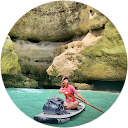This time we will consider another place for kitesurfing in the south of Portugal called Alvor.

This remarkable spot has many positive qualities, like:
– White sand beach and landscape high cliffs.
-Center of the city with many clubs and restaurants.
-Affordable housing.
-And the most important thing is that there is a kitesurf lagoon (Ria Alvor) for learning kitesurfing and just 100 meters from open ocean with a wide picturesque beach.
Depending on the direction of the wind and the tide (water level in the lagoon) you can choose a place for kitesurfing – lagoon or Ocean.
Local kitesurf schools carefully select the time for the lesson, since the water level in the lagoon should not be very high (High tide 2m.) Or too shallow (low tide 10cm.)
Alvor River is ideal for kitesurfing teaching at various levels and ages, deep water for more advanced students and shallow for beginner levels of preparation.

Standard direction of the wind in the spring and summer is north, northwest. In the north-west direction there is the opportunity to ride a kite in an open ocean on the beach of Alvor.
If you compare part lagoon of Alvor with part lagoon of Lagos, you can find advantages and disadvantages.
Alvor kitesurf shortcomings: You need to walk far from parking, a lot of movement of sailing and motor boats to port of Alvor, wind comes later or does not reach than part of Lagos, at High tide you can ride only on fairway because of lack of water, cost of kite lessons and rent kitesurfing equipment more expensive.
Kitesurf Alvor Advantages: wind is much smoother and stronger than in Lagos, the direction of the wind to onshore.
For those who still study at our kitesurfing school, we will make a special offer.
| Courses | Price |
|---|---|
| 1 day (incl. 3 hours group lesson max. 4 students) | €100 |
| 5 days (incl. 15 hours group lesson max. 4 students) | €400 |
| private lesson (incl. 2 hours with private instructor) | €140 |
| half-private lesson (incl. 3 hours max. 2 students) | €150 |
| 1 day rental (kite, bar, board, wetsuit, harness) | €65 |
Alvor River (kitesurfing lagoon) is a small Portuguese river with ideal wind and geological conditions for various water sports, including for the training and practice of kitesurfing.

Formed by combining four streams born on the southern slope Serra de Monchique, Ribeira do Farell & Ribeira do Torre (flowing into its eastern coast) & Odiáxere stream with rich stream Arão (which flows to west coast).
From there he establishes a wide estuary (kitesurf lagoon) with shallow, clean and relatively warm sea water and which is a natural border between cities of Alvor and Lagos (the municipality of Portimão and Lagos) and flows into Atlantic Ocean.
Ria de Alvor (kitesurfing lagoon) is recognized as a site a natural national reserve, it includes gray dunes, oyster farms, beaches and estuaries, agricultural land, semi-natural weeds, pine forests and salt marshes, and shelters for various species of birds and animals, representing public and national interest under the Habitat Directive.

Alvor Castle (Ruinas do Antigo Castelo / Forte de Alvor), built in 7th century, is based on the Phoenician, later Greek and Carthaginian style, built and conquered by Hannibal, who renamed it Porto Hannibal, which would be a basis of Roman settlement of Barcínia.
Later it was conquered by Arabs, who called it Albus, and the development process began, which continued until destruction of Christian age, because of the earthquake of 1755, they destroyed walls, fortifications are only remnants this castle that still exist.
– Chapel of Nossa Senhora da Rocha (Chapel de Nossa Senhora da Rocha)
– Church Divino Salvador de Alvor (Igreja Parroquial de Alvor, Igreja do Divino Salvador) – built-in styles of Manuelito and Rococo, the longitudinal church consists three tiers with expressive main sides and side arcades.
Main facade of 18th century emphasizes entrance hall with a baroque interior, main additional altars in the Renaissance style with chapels in Rococo style.

– Misericordia Church (Igreja da Misericórdia), a 15th-century church comprising a unique stucco tied, and a simple curved facade.
Call or WhatsApp Us for make reservation +351928024066








 WhatsApp us
WhatsApp us